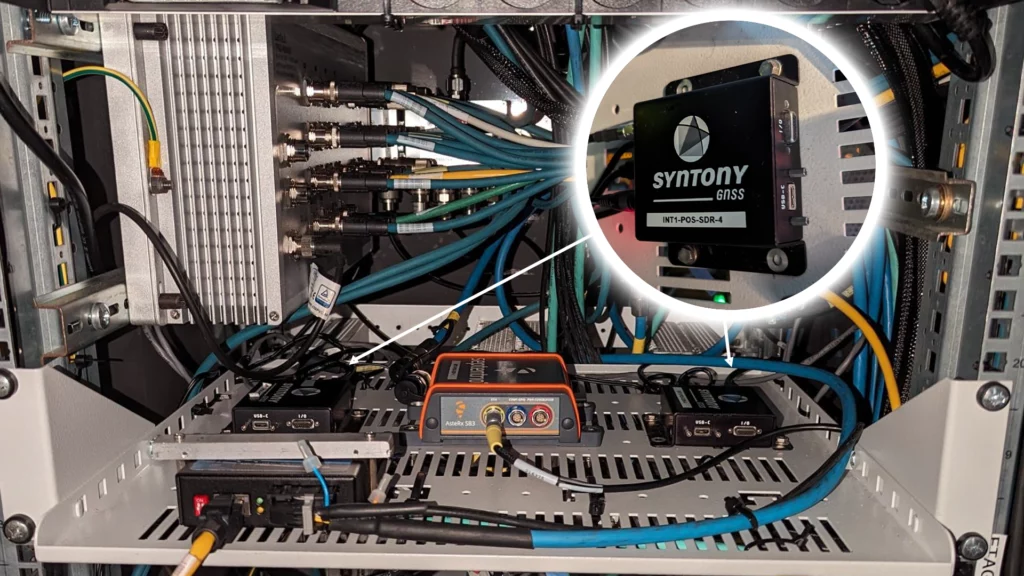Introduction to GNSS in Rail Safety
Rail transportation is at a pivotal moment of technological evolution. The need for safer, more efficient systems has driven the adoption of GNSS (Global Navigation Satellite System) technology. Unlike traditional systems that rely on physical trackside beacons, GNSS-based solutions provide real-time, high-precision location data while reducing infrastructure costs. However, the integration of GNSS into rail systems is not without challenges.
Multipath errors, signal interference, and the stringent safety requirements of rail networks demand innovative approaches. To address these issues, Syntony GNSS and Hitachi Rail have partnered on a cutting-edge project aimed at achieving Safety Integrity Level 4 (SIL 4), the highest safety standard in railway systems. This collaboration combines advanced GNSS receivers with satellite signal map matching (SSM), setting a new benchmark for train positioning and autonomy.
Understanding GNSS Challenges in Rail Networks
Traditional train positioning systems often rely on radio beacons placed at regular intervals along railway tracks. These systems have high installation and maintenance costs, and their accuracy diminishes over time due to environmental and mechanical wear. GNSS offers a promising alternative, but its application in rail networks comes with its own set of challenges:
- Signal Masking and Multipath Effects: Urban environments and mountainous regions can block or distort GNSS signals, leading to inaccuracies.
- Cold Starts: After long downtimes or relocations, trains cannot rely on prior position data, making initial localization critical.
- Safety Standards: Meeting SIL 4 requires precise and fail-safe positioning, particularly in high-traffic rail corridors where errors can have catastrophic consequences.
The project between Syntony GNSS and Hitachi Rail directly addresses these challenges with a holistic approach to GNSS integration.

Innovative Technologies Redefining Train Safety
- Satellite Signal Map Matching (SSM)
A core component of the project is the SSM algorithm. This technology enhances GNSS accuracy by matching received satellite signals to pre-mapped points of interest (POIs) along rail tracks. Unlike traditional systems that estimate positions based on continuous movement, SSM identifies specific POIs with remarkable precision.
This technique is particularly effective in scenarios where tracks run parallel, such as multi-line urban rail systems. By correlating satellite data with known georeferenced points, SSM minimizes the risk of mislocalization, a critical factor in avoiding collisions and ensuring passenger safety.
Moreover, SSM excels in handling cold starts. Even when a train’s prior location is unknown, the algorithm can identify its exact position by correlating current satellite signals with stored map data. This capability sets it apart from traditional GNSS systems, which struggle under similar conditions.
- Syntony’s ORION GNSS Receiver
At the hardware level, Syntony GNSS’s ORION receiver is integral to the project. The ORION platform combines a software-defined radio (SDR) capable of processing GPS L1/L5 and Galileo E1/E5a signals with patented map-matching functionality.
This advanced receiver ensures reliable operation even in challenging environments. For instance:
- Cold Start Detection: The receiver can localize the train without prior movement or knowledge of its location.
- Track Differentiation: By analyzing signal correlation quality, the system determines the exact track the train occupies, crucial in multi-track scenarios.
- Scalability: The ORION receiver’s software-defined architecture allows for easy updates and compatibility with evolving GNSS standards.
- Industrial-Grade Implementation
The autonomous location software (ALS) that will be running on Syntony’s platform operates on an industrial-grade computer approved for railway applications. This robust setup ensures reliability and durability under demanding operational conditions, from extreme weather to constant vibration.
Real-World Applications and Testing
Field tests have been pivotal in validating the project’s technologies. In Vélizy, France, simulations and real-world trials were conducted using both rooftop antennas and onboard systems. These tests demonstrated:
- Exceptional positioning accuracy, even in complex rail networks.
- Reliable cold starts, eliminating the need for hybrid systems involving inertial navigation or odometry.
- Scalability for integration into diverse rail environments globally.
The partnership’s ultimate goal is to achieve SIL 4 by the end of 2025, paving the way for widespread adoption of GNSS-based systems in rail networks worldwide.

Implications for the Future of Rail Transportation
Once fully implemented, the GNSS-based train positioning system developed by Syntony GNSS and Hitachi Rail will revolutionize rail operations. Key benefits include:
- Enhanced Safety: Precise positioning minimizes the risk of accidents, particularly in high-traffic corridors.
- Cost Efficiency: By reducing reliance on physical infrastructure, rail operators can significantly cut maintenance expenses.
- Autonomous Operations: GNSS-based systems are foundational for next-generation autonomous trains, which promise increased efficiency and reduced human error.
This innovation also aligns with broader industry trends toward sustainability and smart mobility. With urbanization driving demand for efficient public transit, advanced GNSS technologies provide scalable solutions to meet these needs.
Broader Impacts on GNSS Applications
The success of this project highlights the growing versatility of GNSS in non-traditional domains. Beyond rail, similar technologies could enhance safety and efficiency in industries like maritime transport, autonomous vehicles, and mining operations. By demonstrating the feasibility of high-precision GNSS in rail networks, Syntony GNSS and Hitachi Rail are setting a precedent for cross-sector innovation.
The collaboration between Syntony GNSS and Hitachi Rail marks a significant milestone in the evolution of rail transportation. By overcoming the limitations of traditional systems and leveraging the full potential of GNSS, this partnership is creating safer, more efficient, and more sustainable rail networks. As the project progresses toward achieving SIL 4, it promises to redefine standards for train positioning and set the stage for a new era in autonomous rail technology.
